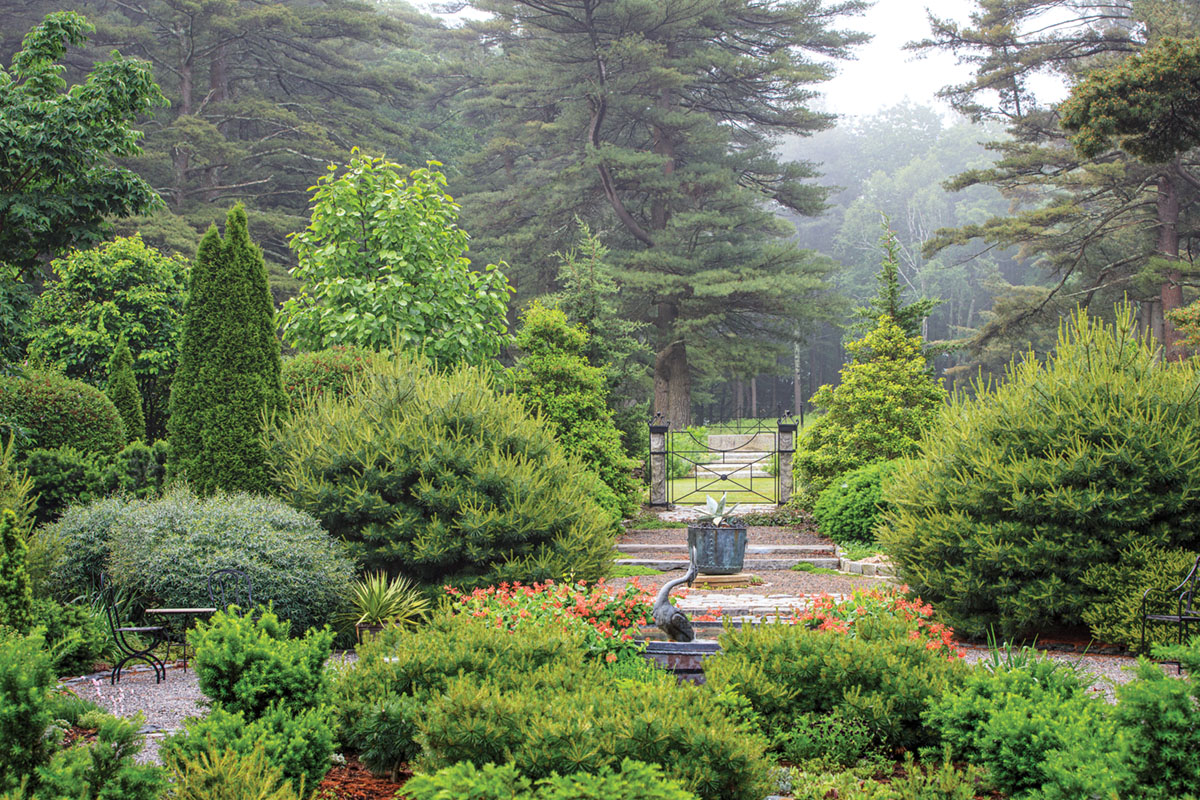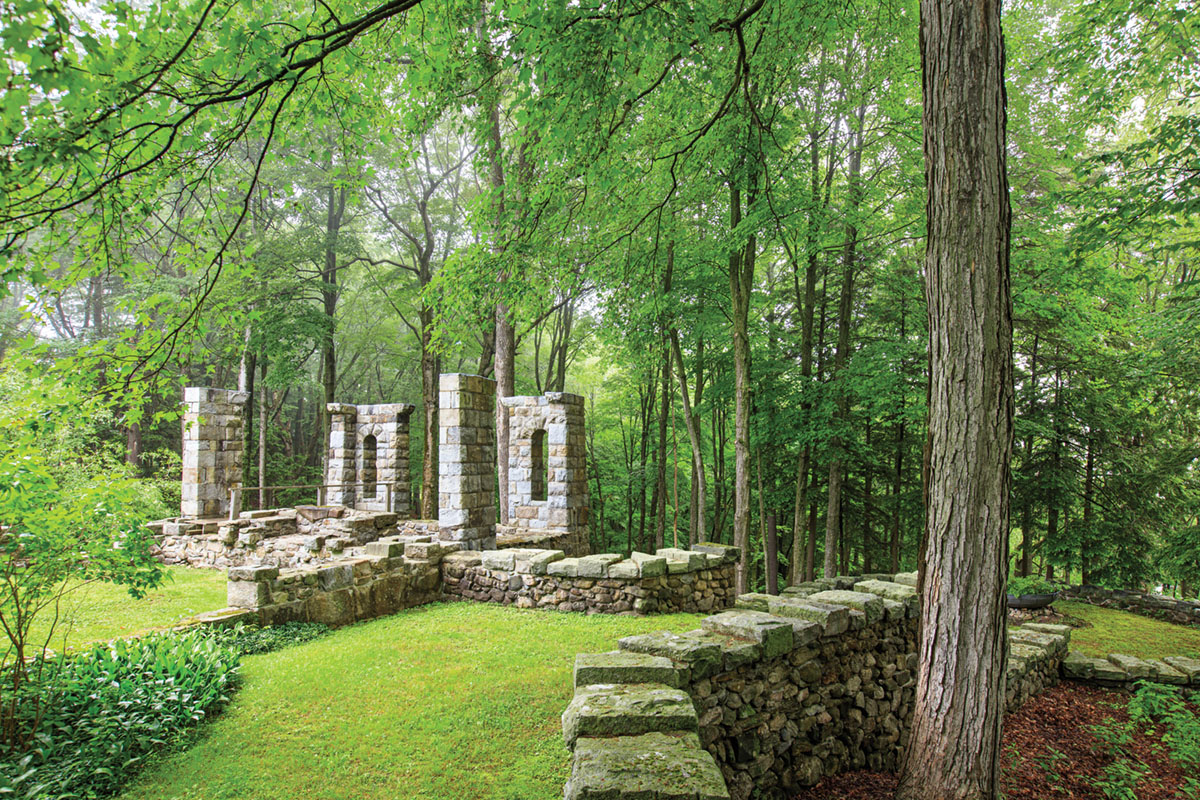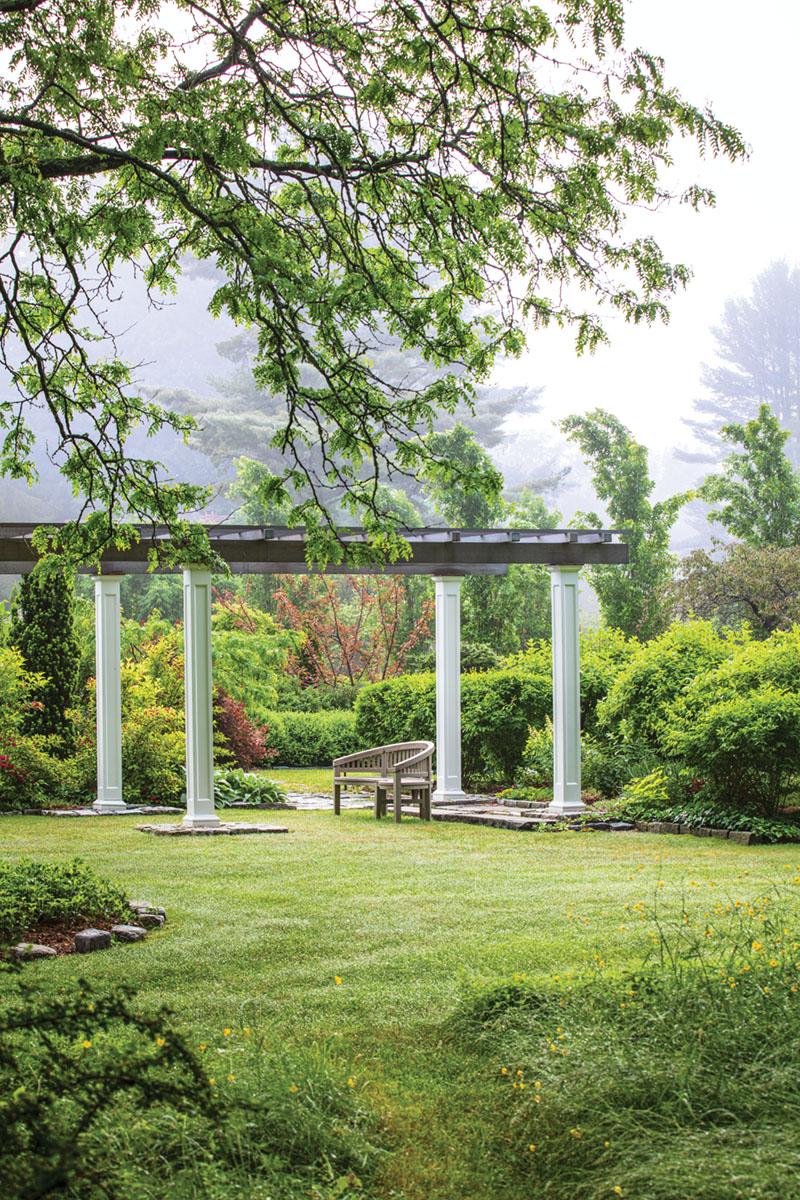
John created a dryscape for a side axis dominated by succulents, nepeta, thermopsis, and a vintage mock orange.
John Funt and Rick Childs knew they were fortunate to find one of the only flat 50-plus acres of land in Norfolk, Connecticut, when they purchased High Meadows in 2002. Initially, the main draw was the serene and beautifully proportioned 1917 Colonial Revival house, one of the later works of renowned architect Ehrick Rossiter. At first, they focused on creating a unified vision within the house. But soon the land spoke to them, and they answered.

When he’s not in the garden, artist John Funt translates its bounty onto canvas in a barn converted into a studio.

Rick Childs’ idea for dressing up a toolshed included dentil molding and quoins.
Both partners had busy agendas when the time came to address the landscape. Rick was an ER physician. John (the son of Allen Funt of Candid Camera fame) is a fine artist who refocused his career after working for Tiffany & Co. Both Rick and John are passionate gardeners: Rick is an avid (some might say obsessed) collector of conifers, while John takes a more diverse, artistic approach. Finding common ground and merging visions with their new site was an eye-opener for both.

The garden’s central axis features a heron wading in a pool. Noninvasive honeysuckle trained to crawl on a horizontal support provides a spark of color in a sea of green.
Originally, the pair were planning to downsize in the horticultural arena. They figured that gardening would take a back seat. But the huge, level expanse with nothing but ancient pines toward the periphery felt empty without a garden. And once John began planning spatially, he could not confine his vision. The space begged for the symmetry of a formal garden; it needed axes and cross-axes. And the challenge of balancing the scene against its open backdrop demanded certain dimensions. “It had to be an extension of the house,” John explains. “The proportions just came to me.” With a back terrace that stretches 60 feet wide, it was essential to go big.

The original 1890s structure on the property burned, but its ruins remain as a romantic secret retreat.
There were parameters: “It had to feel completely American,” John says. “I was influenced by the classical American landscape architects and the location.” That said, he designs from the heart and is the first to confess he accesses his “inner romantic” at all turns. Rick’s love for conifers was just the ticket for hiding and revealing scenes within the space to achieve mystery and compelling moodiness. Evergreens are incorporated everywhere, both as leitmotifs and for their individual sculptural beauty. Even beyond the formal garden pathways, the garden feels embraced rather than floating in space, due to the immense distant white pines planted by the original owners—like a frame beyond a frame.

Once the original driveway to the house, an allée of Norway spruces leads to the carriage barn/artist studio.
Both John and Rick are collectors. In the garden, that penchant is expressed in an extra-ordinary selection of plants. Nothing was there when they came except a few lonesome peonies that were incorporated into the current garden. But the lack of a previous landscape allowed generous latitude for design with no sense that they were treading on tradition.
John found six matching fastigiate pin oaks to serve as sentinels. He also happened upon many magnolias, all sorts of conifers, and multiple lilacs to provide density. “But I’m not a plant snob,” he insists, offering his fondness for ivy, ajuga, nepeta, and violas as proof that he doesn’t discriminate against more common plants.

Metalwork by Stephen Bangs supports annual vines on the pergola.

A pair of Serbian spruces adorns the entrance drive.
All the plant selections are positioned within the rubric of the neat, tidy hardscape. For the basic structure, they chose gravel and curbstone with wrought iron edging. John jokes, “We never met a cobblestone we didn’t like.” For vertical elements, custom-crafted metalwork pergolas by local artisan Stephen Bangs sprang from John’s drawings. “That sort of thing is just the most beautiful investment you can make,” John says of the custom craftsmanship.

An outdoor sitting room was given grillwork to crown an axis flanked by the blushing spring foliage of crabapple trees.
What has evolved is a deeply soothing scene. The garden hums along in different shades of green with periodic accents supplied by flowering shrubs and perennial ground covers. Shapes and textures interweave to form a sophisticated blend. John admits the garden was purposefully planted densely.
“Some removals will be necessary,” he says, “but that’s understood.” And he chose fast-growing shrubs and trees to make an immediate statement. Meanwhile, his training in art did more than help with conceptualization; it also furnished deeper lessons. “I learned to cherish my materials,” he says, “and I was taught to treat everything with dignity.”

A cauldron holding a shade-loving astilbe accents a stone-encircled overlook.
The result is profoundly strong but also embracingly soft. This is a garden meant to feed and serve all the senses. Most important, all of High Meadows’ residents feel embraced—beyond the human inhabitants. Rick and John conscientiously steward the wildlife in, above, and beyond their landscape. The result is palpable harmony on many levels. “We have a visceral response to being here,” John says. “This must have been something that was waiting to happen in our lives.”

Two Parrotia persica trees rise above a retaining wall.
JOHN FUNT ON PAINTERLY COLOR FOR THE GARDEN
Whether in his studio or in the gardens at High Meadows, John Funt is always highly cognizant of color. Even when confined indoors due to weather, “I garden on my easel,” he says of the landscapes he paints. And in all his expressions, a lush sense of verdure prevails. Green is always the underlying theme. That said, when designing his landscape, he incorporates pops of color. Often, seasonal foliage provides a spark, or seasonal flowering shrubs step in and out of the limelight. It’s a subtle expression, and it’s immensely soothing and unpretentious. It just feels right.
When John refers to a pop of color, he does not necessarily mean something bright. One of his favorite plants is Viola ‘Bowles Black,’ which has matte midnight petals so dark they almost slip into the shadows. That heirloom ground cover has been allowed to self-seed and scamper around everywhere as a signature in the garden and a nod toward the era when the house was built. “It is almost always in blossom,” he says.

The bronze foliage and tissue pink blossoms of a Physocarpus ‘Coppertina’ serve up subtle color beside yellow-blooming thermopsis.

A container spills with Petunia ‘Phantom’.
Other ground covers also figure strongly in this landscape of overarching shades of green. Stonecrops (sedums) create carpets in varying degrees of red and orange foliage. Again, they have a dialogue with the blush of copper ninebark leaves, smokebush, and other seasonal flowering shrubs, such as weigela. Dianthus pops into flower and rushes around. Autumn-blooming Japanese anemones are permitted to “go wherever they please,” says John. However, not everything is given entry. And all elements are balanced to achieve masterful layering, just like on a canvas.
The ratios are always carefully conceived, and John sprinkles plants where they might be particularly meaningful. “I was once a ferocious shopper,” he admits. “Now I divide to create color echoes. I feel like a pioneer spirit increasing and redistributing plants.” Plus, one of his greatest delights lies in doing all these things personally. “We don’t have a team of gardeners. It’s basically me, creating everything from the ground up. Places here are just waiting for me to come and work with them. I love that familiarity.”

Smokebush, Cotinus ‘Grace’

John combined a curbstone with a finial to create a chess piece–like ornament.
By Tovah Martin | Photography by Claire Takacs
This story originally appeared in Flower magazine’s May/June 2021 issue. Find Flower in a store near you or subscribe.
On the Cover: In a garden by landscape architect Quincy Hammond, a bench based on Beatrix Farrand’s drawings for the Rose Bench at Dumbarton Oaks sits on an axis through the cutting garden, beneath red-leaved Norway maples. Photo by Lauren Coleman. See story.




